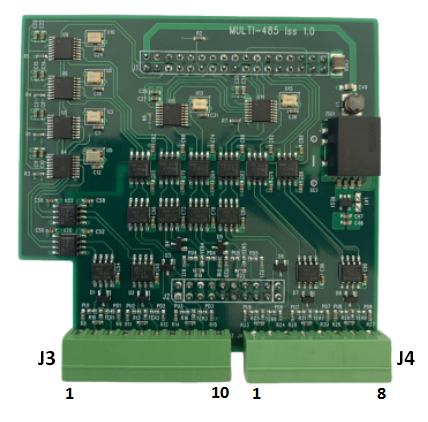Multi RS485 IO Card Configuration
The Multi RS485 board uses multiple SC16IS740 devices to provide I2C and SPI interfaced serial ports
The configuration is done by downloading and installing the device tree overlay files found in the zip file here
Integrator Board NT (CM3/4S) Files
[wget --no-check-certificate 'https://drive.google.com/uc?export=download&id=1pHVvHhVkmF1cfaAXzcOTrPe_S3C9HC1z' -O multiuart.tar.gz]
Integrator Board XT (CM4) Files
[wget --no-check-certificate 'https://drive.google.com/uc?export=download&id=1D9UvhzlU5BvdiPFqLFOYGGyaQqXyQsV1' -O multiuart.tar.gz]
Install Notes :
Disable the serial console and copy all the .dtbo files in the tar zip file to /boot/overlays
# Remove the serial console section from boot cmdline (console=serial1,115200) root@raspberrypi:~# cat /boot/cmdline.txt console=tty1 root=PARTUUID=5e843ba5-02 rootfstype=ext4 fsck.repair=yes rootwait # Disable the serial console service root@raspberrypi:~# systemctl disable serial-getty@ttyS0.service # Install device tree files root@raspberrypi:~# tar -xzf multiuart-cm4.tar.gz root@raspberrypi:~# cd install-files root@raspberrypi:~/install-files# cp *.dtbo /boot/overlays/
Add the single config section below for the respective Integrator board to enable the serial ports, note that the first section may already be in the config.txt file and just need enabling.
# Integrator Board NT #################################################################################### # Enables UART0 onto GPIO32/33 dtoverlay=uart0,txd0_pin=32,rxd0_pin=33,pin_func=7 # Enables UART1 onto GPIO14/15 dtoverlay=uart1,txd1_pin=14,rxd1_pin=15 # Fixes internal clock to fix baud rate issues. enable_uart=1 # Correct UART assignment so 32/33 has ttyAMA0 & 14/15 has ttyS0 dtoverlay=uart_swap dtparam=i2c_arm=on,i2c_arm_baudrate=400000 dtoverlay=spi0-2cs,cs0_pin8=,cs1_pin=7 dtoverlay=i2cuarts dtoverlay=spiuart1 dtoverlay=spiuart2 # Integrator Board XT #################################################################################### # Enables UART1 (ttyS0) on GPIO14/15 enable_uart=1 # Moves UART0 (ttyAMA0) to being on GPIO14/15 (if required) dtoverlay=disable-bt # Enable UART2 (ttyAMA1) on GPIO0/1 dtoverlay=uart2 # Stop HAT card probe on GPIO0+1 during start-up gpio=0-1=a4 dtparam=i2c_arm=on,i2c_arm_baudrate=400000 dtoverlay=spi0-2cs,cs0_pin8=,cs1_pin=23 dtoverlay=i2cuarts dtoverlay=spiuart1 dtoverlay=spiuart2
Reboot the system.
When next booted you can check the I2C ports have been detected by running the below :
root@raspberrypi:~# i2cdetect -y 1
0 1 2 3 4 5 6 7 8 9 a b c d e f
00: -- -- -- -- -- -- -- -- -- -- -- -- --
10: -- -- -- -- -- -- -- -- -- -- -- -- -- -- -- --
20: -- -- -- -- -- -- -- -- -- -- -- -- -- -- -- --
30: -- -- -- -- -- -- -- -- -- -- -- -- -- -- -- --
40: -- -- -- -- -- -- -- -- UU UU -- -- UU UU -- --
50: -- -- -- -- -- -- -- -- -- -- -- -- -- -- -- --
60: -- -- -- -- -- -- -- -- UU -- -- -- -- -- -- --
70: -- -- -- -- -- -- -- --
The serial ports should now be running as :
root@raspberrypi:~# ls /dev/ttySC* /dev/ttySC0 /dev/ttySC1 /dev/ttySC2 /dev/ttySC3 /dev/ttySC4 /dev/ttySC5
Baud rates that can be cleanly obtained on all ttySC* ports (note the divisor number is for information only)
Baud (Divisor) 50 2304 75 1536 150 768 300 384 600 192 1200 96 1800 64 2400 48 3600 32 4800 24 7200 16 9600 12 14400 8 19200 6 38400 3 57600 2 115200 1
If using ttyS0 then be sure to disable it from being a console port

J3
| Pin | Port | Function |
|---|---|---|
| 1 | - | GND |
| 2 | ttySC3 | A |
| 3 | ttySC3 | B |
| 4 | - | GND |
| 5 | ttySC2 | A |
| 6 | ttySC2 | B |
| 7 | - | GND |
| 8 | ttySC1 | A |
| 9 | ttySC1 | B |
| 10 | - | GND |
J4
| Pin | Port | Function |
|---|---|---|
| 1 | ttySC4 | A |
| 2 | ttySC4 | B |
| 3 | - | GND |
| 4 | ttyAMA0 | A |
| 5 | ttyAMA0 | B |
| 6 | - | GND |
| 7 | ttyS0 / ttyAMA1 | A |
| 8 | ttyS0 / ttyAMA1 | B |
Main Board 8 Way
| Pin | Port | Function |
|---|---|---|
| 1 | - | GND |
| 2 | ttySC0 | A |
| 3 | ttySC0 | B |
| 4 | - | GND |
| 5 | - | GND |
| 6 | ttySC5 | A |
| 7 | ttySC5 | B |
| 8 | - | GND |